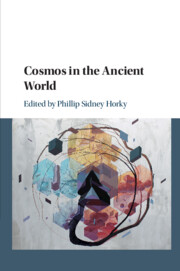Book contents
- Cosmos in the Ancient World
- Cosmos in the Ancient World
- Copyright page
- Dedication
- Epigraph
- Contents
- Contributors
- Acknowledgements
- An Historical Note on Kόσμος – Terminology
- Abbreviations
- Introduction
- Chapter 1 When Did Kosmos Become the Kosmos?
- Chapter 2 Ordering the Universe in Speech
- Chapter 3 Diakosmêsis
- Chapter 4 Aristotle on Kosmos and Kosmoi
- Chapter 5 Order and Orderliness
- Chapter 6 Polis as Kosmos in Plato’s Laws
- Chapter 7 Relating to the World, Encountering the Other
- Chapter 8 Tradition and Innovation in the Kosmos–Polis Analogy
- Chapter 9 Cosmic Choruses
- Chapter 10 All the World’s a Stage
- Chapter 11 The Architectural Representation of the Kosmos from Varro to Hadrian
- Chapter 12 “The Deep-Sticking Boundary Stone”
- Chapter 13 Cosmic Spiritualism among the Pythagoreans, Stoics, Jews and Early Christians
- Afterword
- Bibliography
- Index Locorum
- General Index
Chapter 13 - Cosmic Spiritualism among the Pythagoreans, Stoics, Jews and Early Christians
Published online by Cambridge University Press: 18 June 2019
- Cosmos in the Ancient World
- Cosmos in the Ancient World
- Copyright page
- Dedication
- Epigraph
- Contents
- Contributors
- Acknowledgements
- An Historical Note on Kόσμος – Terminology
- Abbreviations
- Introduction
- Chapter 1 When Did Kosmos Become the Kosmos?
- Chapter 2 Ordering the Universe in Speech
- Chapter 3 Diakosmêsis
- Chapter 4 Aristotle on Kosmos and Kosmoi
- Chapter 5 Order and Orderliness
- Chapter 6 Polis as Kosmos in Plato’s Laws
- Chapter 7 Relating to the World, Encountering the Other
- Chapter 8 Tradition and Innovation in the Kosmos–Polis Analogy
- Chapter 9 Cosmic Choruses
- Chapter 10 All the World’s a Stage
- Chapter 11 The Architectural Representation of the Kosmos from Varro to Hadrian
- Chapter 12 “The Deep-Sticking Boundary Stone”
- Chapter 13 Cosmic Spiritualism among the Pythagoreans, Stoics, Jews and Early Christians
- Afterword
- Bibliography
- Index Locorum
- General Index
Summary
This chapter traces a genealogy of pneumatic cosmology, covering the Pythagoreans of the fifth century BCE, the Stoics of the third and second centuries BCE, the Jews writing in Alexandria in the first century BCE and the Christians of the first century CE. Starting from the early Pythagoreans, ‘breath’ and ‘breathing’ function to draw analogies between cosmogony and anthropogony – a notion ultimately rejected by Plato in the Timaeus and Aristotle in his cosmological works, but taken up by the Posidonius and expanded into a rich and challenging corporeal metaphysics. Similarly, the Post-Hellenistic philosopher and biblical exegete Philo of Alexandria approaches the cosmogony and anthropogony described in Genesis (1:1-3 and 1:7) through Platonist-Stoic philosophy, in his attempt to provide a philosophically rigorous explanation for why Moses employed certain terms or phrases when writing his book of creation. Finally, the chapter sees a determined shift in the direction of rejecting pneumatic cosmology for a revised pneumatic anthropogony in the writings of the New Testament: by appeal to the ‘Holy Spirit’ (πνεῦμα ἅγιον), early Christians effectively adapted the Stoic metaphysics of ‘breath’, with its notions of divine intelligence and bonding, to the ecclesiastical project of building a Christian community conceived of as the ‘body of Christ’.
Keywords
- Type
- Chapter
- Information
- Cosmos in the Ancient World , pp. 270 - 294Publisher: Cambridge University PressPrint publication year: 2019
- 3
- Cited by

